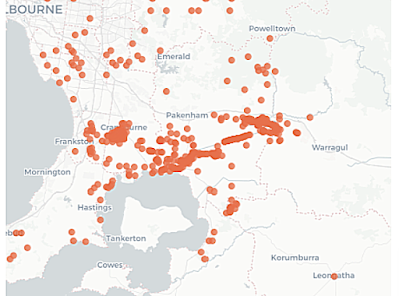The Southern Brown Bandicoot is an indigenous, endangered mammal that was once relatively abundant in our district. Although there are still some current sightings recorded in West Gippsland, their numbers are in decline.
 |
| Southern Brown Bandicoot - Cranbourne Botanic Gardens |
The range of the Southern Brown Bandicoot is now severely restricted and its distribution is very fragmented with numerous small populations that are unconnected. Threats include predation by foxes and cats (especially of young), habitat loss due to urbanization and farmland encroachment, inappropriate fire regimes, road traffic, etc.
 |
| "Once upon a time" |
This fairly secretive animal is rarely seen very far from dense cover. It is a marsupial with a backward-facing pouch that avoids dirt entering as it scratches in the soil and leaf litter for its diet of insects, larvae, worms, and other invertebrates. Diggings are often the main indication of a bandicoot’s presence a funnel-shaped hole rather than the bowl-shaped hole of a rabbit.
There is some evidence that bandicoot diggings contribute to
improved soil condition. “… one bandicoot can make 41 digs an hour. That's
nearly 500 digs a night, equating to around 13 kilograms of soil being turned
over every night, or 4.8 tonnes a year.” - (The Conversation Feb 28th
2020)

Left: Bandicoot (funnel-shaped) Right: Rabbit (bowl-shaped)
 |
| Credit: phys.org (L Valentine) |
The Southern Brown Bandicoot constructs a nest on the ground under the cover of grasses and shrubs. It doesn’t dig a burrow, although there have been some records of bandicoots using the burrows of other animals. Key part of habitat is dense low vegetation cover such as tussocky plants, bracken, even blackberries.
The Southern Brown Bandicoot seems to be both nocturnal and diurnal at times. There are always good chances of seeing one in the daytime at the Cranbourne Botanic Gardens. They are opportunistic breeders and if conditions are right, may have several litters of 2 or 3 young in a season.
 |
| Some locals have them on their front lawn! |
Bandicoots in Australia have generally fared very poorly since European settlement. It is incumbent of us to help ensure this endearing little mammal avoids extinction.
Further reading
Cardinia Shire’s bandicoot page with links to a factsheet, a strategic management plan, habitat and shelter guide, etc.
Bass Coast Biolinks Plan to “provide connectivity in the landscape by linking remnant patches of indigenous vegetation using biolinks or wildlife corridors. The aim is to restore ecological connectivity … and allow for genetic diversity in breeding populations to ensure long term viability of isolated species such as the Southern Brown Bandicoot.”
Westernport Biosphere bandicoot recovery program.
Benjamin Bandicoot by Banjo Patterson – All Poetry.
No comments:
Post a Comment